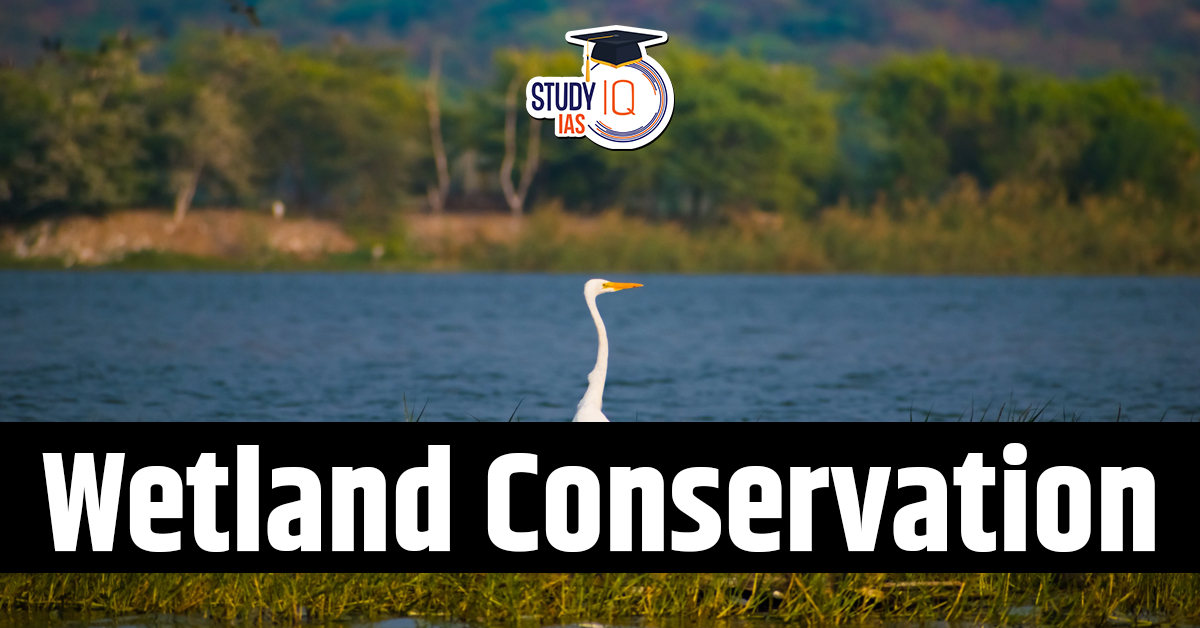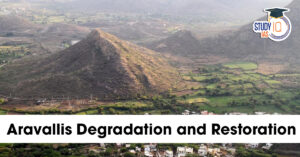Table of Contents
Context: The suo motu public interest litigation by the Meghalaya High Court recently, to monitor the conservation of wetlands in the State, brings the focus back on this important ecosystem.
Current Distribution of Wetlands
- Global: Wetlands cover about 1 million km² (~6% of the Earth’s surface) and provide 40.6% of global ecosystem services.
- India: According to the National Wetland Decadal Change Atlas (2017-18) by the Space Applications Centre (SAC), ISRO, wetlands in India cover 98 million hectares. Of this:
- 6% are natural wetlands (43.9% inland and 22.7% coastal).
- 4% are man-made wetlands.
- 75 Ramsar sites (as of 2023) cover 33 million ha (~8% of total wetlands in India).
| Facts |
|
Challenges Associated with Wetlands
Quantitative Decline
- 50% of global wetlands lost since 1900.
- The wetland surface declined by 35% (1970-2015) at an annual loss rate of 78% (Wetland Extent Trends Index).
- In India, 30% of natural wetlands were lost in four decades (Wetlands International South-Asia).
- Mumbai lost 71% of its wetlands (1970-2014).
- East Kolkata Wetlands shrunk by 36% (1991-2021).
- Chennai lost 85% of its wetlands (WWF study).
Qualitative Degradation
- Biodiversity loss: Since 1970, 81% of inland wetland species and 36% of coastal & marine species have declined.
- Pollution: Industrial effluents, sewage discharge, and solid waste dumping.
- Urbanization & Land Use Change: Expansion of cities, real estate projects, and infrastructure development.
- Climate Change Impacts: Wetlands act as carbon sinks but rising temperatures, sea-level rise, and erratic rainfall patterns impact their stability.
- Weak Governance: Fragmented policies, lack of inter-agency coordination, and ineffective implementation of conservation measures.
What Needs to Be Done?
- Holistic Conservation Approach: Integrate wetland conservation into urban and regional planning.
- Adopt an Ecosystem-based Approach, as advocated in Ramsar COP14.
- Strengthening Legal Protection: Enforce the Wetlands (Conservation and Management) Rules, 2017 more effectively.
| Wetlands (Conservation and Management) Rules, 2017 |
| The Wetlands (Conservation and Management) Rules, 2017 were notified under the Environment Protection Act, 1986, to protect and manage wetlands in India through a decentralized approach.
Key Features:
|
- Community Participation: Involve local communities in wetland management for sustainable use.
- Nature-Based Solutions: Use wetlands for flood control, carbon sequestration, and wastewater treatment.
- Scientific Monitoring & Restoration: Periodic wetland assessment using remote sensing & GIS (e.g., ISRO’s Wetland Decadal Change Atlas).
- Mainstreaming Wetlands in Development Plans: Wetland conservation should align with Sustainable Development Goals (SDGs), climate change adaptation, and disaster risk reduction.
Types of Wetlands
- Coastal Wetlands:
- Coastal wetlands are found in the areas between land and open sea that are not influenced by rivers such as shorelines, beaches, mangroves and coral reefs.
- Eg: mangrove swamps found in sheltered tropical coastal areas.
- Marshes: These are wetlands that are permanently flooded or flooded during high water periods at the edges of rivers, streams, lakes, or ponds.
- Sedge meadows (or wet meadows): These are wetlands with permanently or near-permanently saturated soils. They may form a transitional zone between marshes and other wetlands with less-saturated soils, or around groundwater discharge zones.
- Fens and seeps: These are wetlands that are fed by groundwater that “seeps” out to the soil’s surface.
- Bogs: These are basin wetlands for which precipitation is the only source of water; they are typically not fed by surfacing groundwater or streams.
- Swamps: These are wetlands dominated by woody vegetation that typically have standing water during at least certain times of the year.
Importance of Wetlands
- Highly Productive Ecosystems: Wetlands are highly productive ecosystems that provide the world with nearly two-thirds of the fish harvest.
- Integral Role in the Ecology of the Watershed: The combination of shallow water and high levels of nutrients are ideal for the development of organisms that form the base of the food web and feed many species of fish, amphibians, shellfish and insects.
- Carbon Sequestration: Wetlands’ microbes, plants and wildlife are part of the global cycles for water, nitrogen and sulphur. Wetlands store carbon within their plant communities and soil instead of releasing it to the atmosphere as carbon dioxide.
- Lowering Flood Heights and Reducing Soil Erosion: Wetlands function as natural barriers that trap and slowly release surface water, rain, snowmelt, groundwater and flood waters. Wetland vegetation also slows the speed of flood waters, lowering flood heights and reducing soil erosion.
- Critical to Human and Planet Life: More than one billion people depend on them for a living, and 40% of the world’s species live and breed in wetlands.
Threats faced by Wetlands
Wetlands face a range of challenges that jeopardize their existence and ecological functions.
- Urbanization Pressure: Wetlands located near urban areas are increasingly at risk due to the demand for residential, industrial, and commercial development. Encroachment, both planned and unplanned, poses a significant threat to their survival.
- Pollution: Wetlands act as natural filters, but they are susceptible to pollution. While they can effectively remove fertilizers and pesticides from agricultural runoff, they are unable to address pollutants such as mercury from industrial sources and other forms of pollution. This pollution not only affects the wetland ecosystems but also endangers the quality of drinking water supplies.
- Agricultural Conversion: Extensive wetland areas have been converted into agricultural fields, particularly for paddy cultivation. The construction of reservoirs, canals, and dams to support irrigation has significantly altered the hydrology of associated wetlands, disrupting their natural functions.
- Climate Change: Wetlands are sensitive to the impacts of climate change, including increased air temperatures, shifts in precipitation patterns, more frequent extreme weather events (such as storms, droughts, and floods), elevated atmospheric carbon dioxide levels, and rising sea levels. These changes can disrupt the delicate balance of wetland ecosystems.
- Dredging: Dredging, which involves the removal of material from wetland or riverbed areas, poses a threat to wetlands. It lowers the water table in surrounding areas and can lead to the drying out of adjacent wetlands, disrupting their ecological integrity.
- Draining: Wetlands are drained by the creation of ditches that collect and divert water away from the wetland. This process lowers the water table within the wetland, resulting in its desiccation and degradation.
Initiatives for Wetland Conservation
Global Efforts
Ramsar Convention
- It is an intergovernmental treaty under UNESCO.
- Provides the framework for the conservation and wise use of wetlands and their resources.
- It was signed in Ramsar(Iran) on February 2, 1971. (World Wetland Day)
- India joined the Ramsar Convention in
- Partners to Ramsar Convention: Birdlife International, IUCN, Wetlands International, WWF, International Water Management Institute, Wildfowl and Wetlands Trust.
- Theme (2025): Protecting Wetlands for Our Common Future.
Montreux Record
- The Montreux Record is a register of wetland sites that are on the Ramsar List of Wetlands of International Importance and are facing or are likely to face ecological changes.
- The record serves as a tool to identify sites requiring special attention and conservation efforts.
World Wetlands Day
- Celebrated on February 2nd each year, World Wetlands Day raises awareness about the value of wetlands and the need for their conservation.
- It provides an opportunity to promote the conservation and wise use of wetlands at a global level.
Decade on Ecosystem Restoration
- The United Nations declared 2021-2030 as the Decade on Ecosystem Restoration.
- This initiative aims to mobilize global efforts to restore and conserve ecosystems, including wetlands, to enhance their ecological functions and promote sustainable development.
International Union for Conservation of Nature (IUCN)
- The IUCN plays a significant role in wetland conservation through various initiatives.
- It provides technical expertise, promotes research, develops conservation strategies, and advocates for the protection of wetland ecosystems at the global level.
Global Environment Facility (GEF)
The GEF supports wetland conservation projects worldwide.
- It provides financial assistance and technical expertise to promote sustainable management practices, restore degraded wetlands, and strengthen the capacity of countries to protect and conserve wetland ecosystems.
National Efforts
- Statutory Protection: In India, the wetlands are regulated under the Wetlands (Conservation and Management) Rules, 2017.
- Action Plan of MoEFCC: The Ministry of Environment, Forest and Climate Change (MoEFCC) supports the implementation of management action plans for over 250 wetlands under schemes such as the National Plan for Conservation of Aquatic Ecosystems, Mangroves and Coral Reefs, and Integrated Development of Wildlife Habitats.


 Aravallis Degradation and Restoration: I...
Aravallis Degradation and Restoration: I...





















